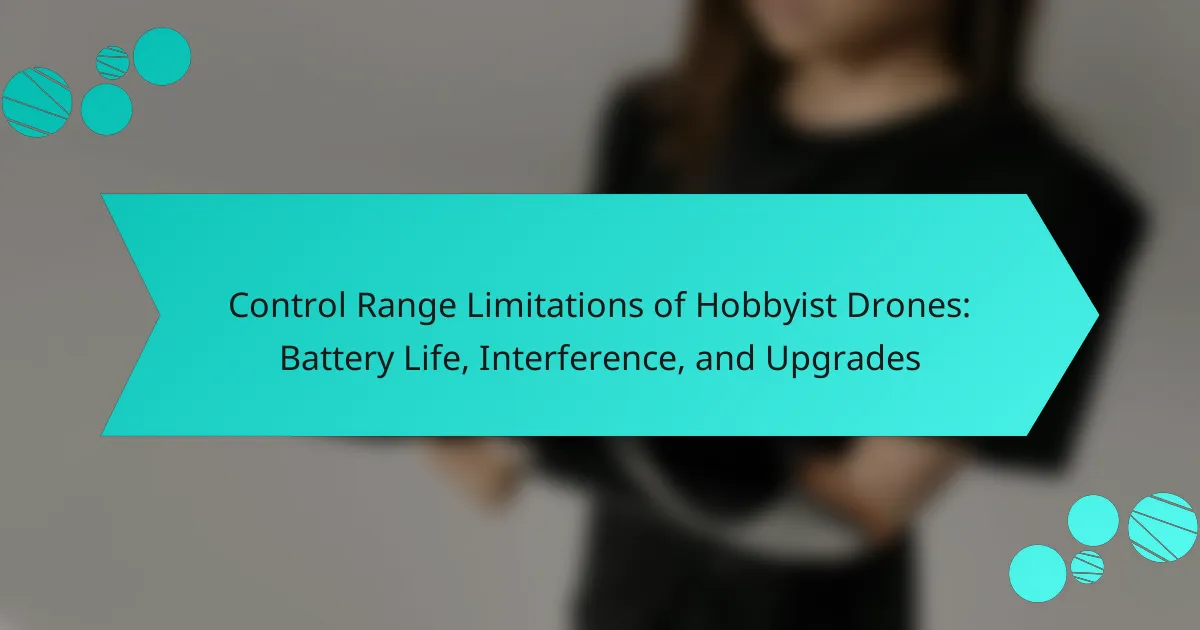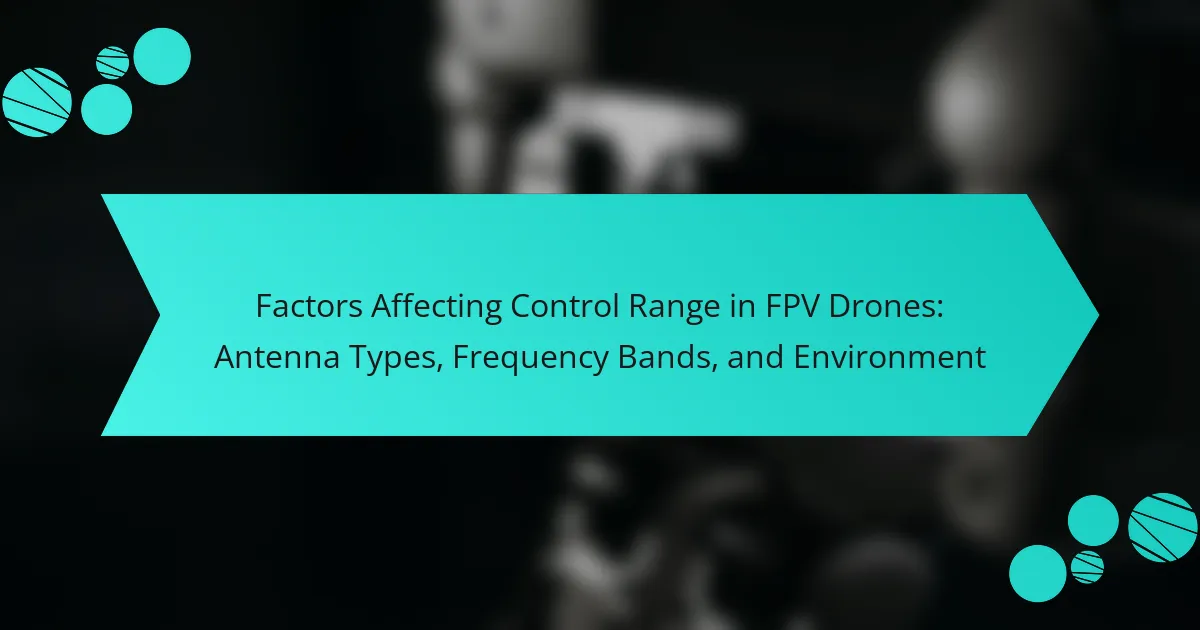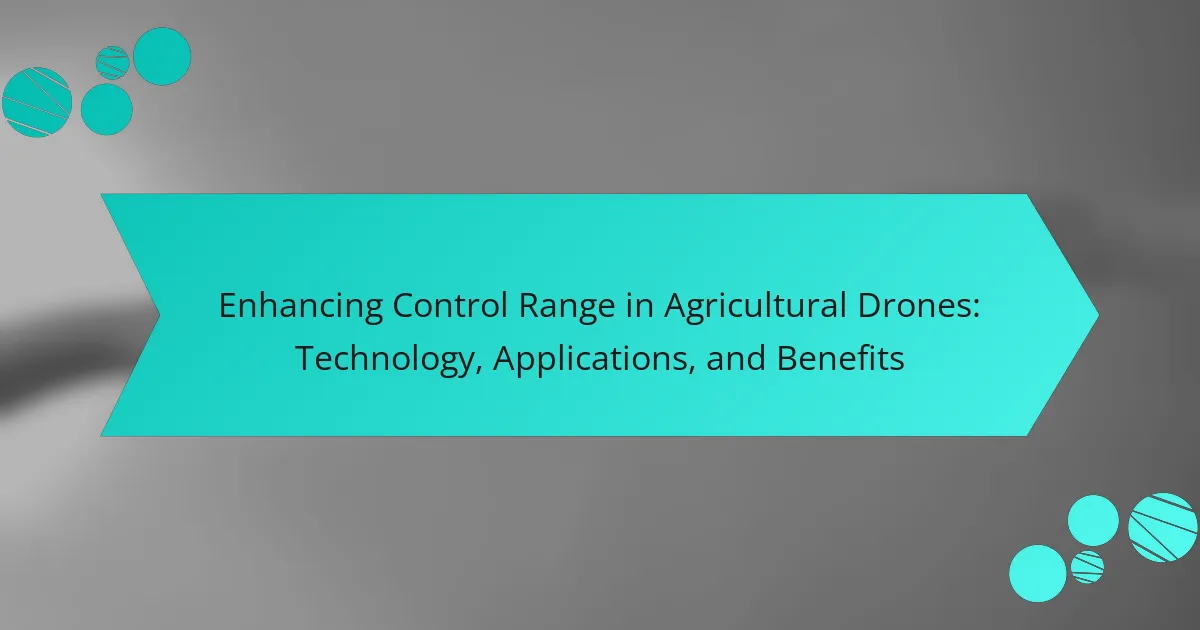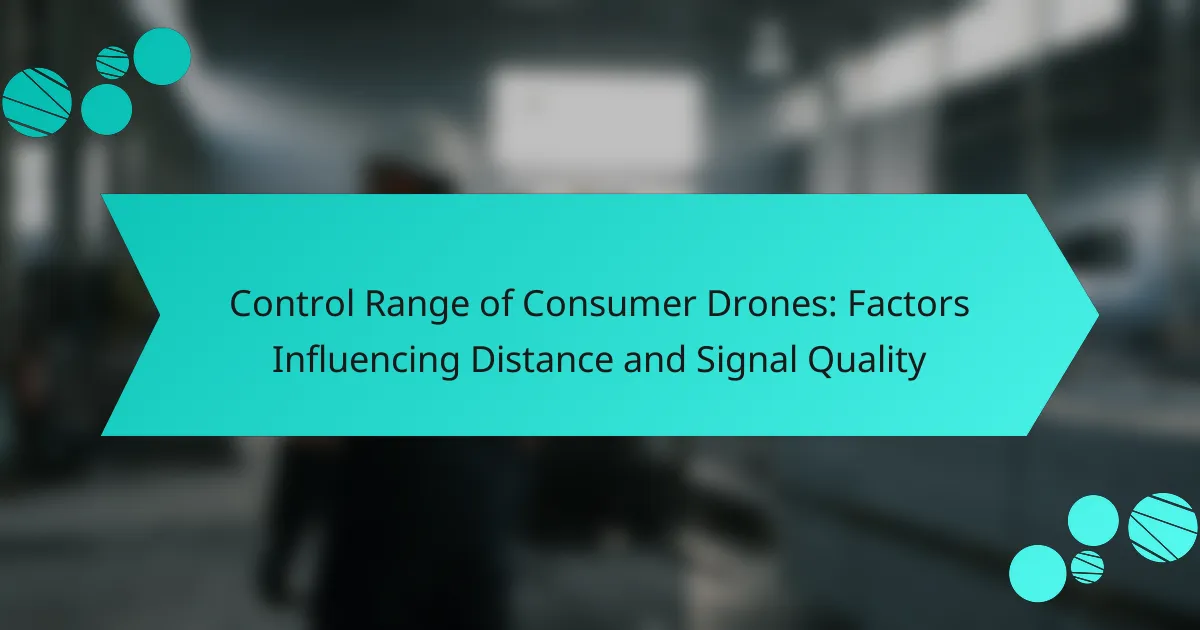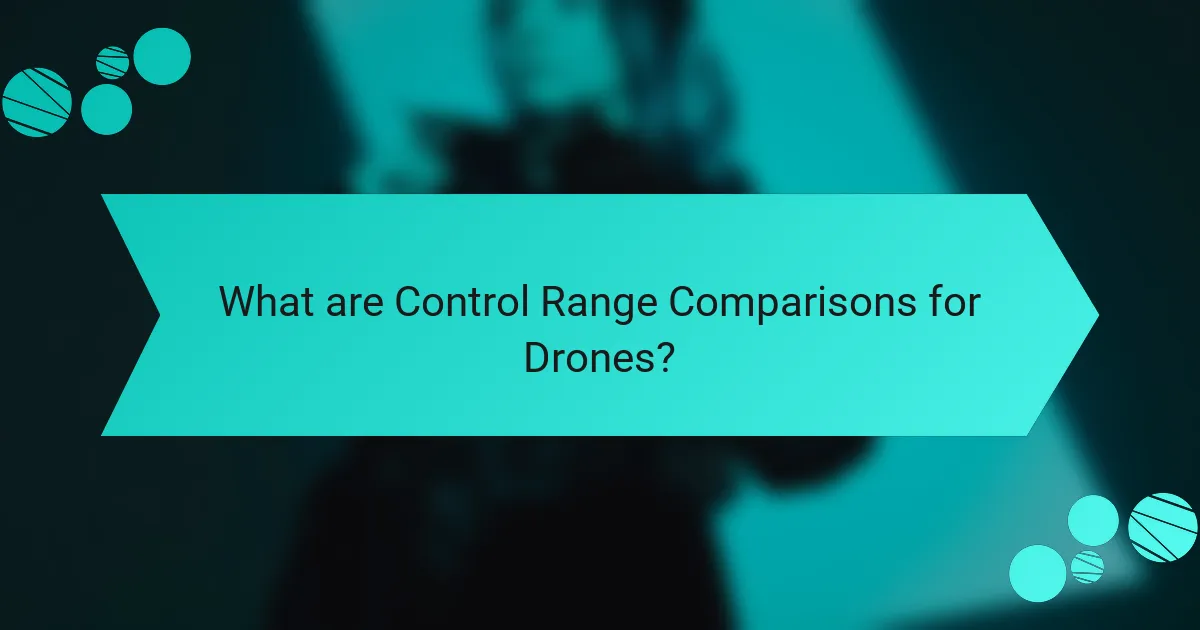
What are Control Range Comparisons for Drones?
Control range comparisons for drones refer to the maximum distance a drone can operate from its controller while maintaining a stable connection. Fixed-wing drones typically have longer control ranges, often exceeding 100 kilometers, due to their aerodynamic design and efficiency. In contrast, multirotor drones generally have shorter ranges, usually between 1 to 10 kilometers, because of their reliance on battery power and rotor configuration. These differences are crucial for applications like surveying or search and rescue, where range can impact operational effectiveness.
How do control ranges differ between fixed-wing and multirotor drones?
Control ranges differ significantly between fixed-wing and multirotor drones. Fixed-wing drones typically have longer control ranges due to their aerodynamic design. They can achieve distances of up to 100 kilometers or more, depending on the model and conditions. This is largely because they can maintain higher speeds and cover larger areas efficiently.
In contrast, multirotor drones generally have shorter control ranges. Most multirotors operate effectively within a range of 1 to 10 kilometers. Their design allows for excellent maneuverability but limits their flight distance compared to fixed-wing counterparts. The shorter range is also influenced by battery capacity and weight.
The differences in control range can be attributed to the flight mechanics of each type. Fixed-wing drones require less power to stay airborne, allowing for extended flight times and distances. Multirotors, while versatile, consume more power due to their vertical takeoff and landing capabilities.
In summary, fixed-wing drones excel in long-distance operations, while multirotor drones are more suited for short-range tasks. This distinction is crucial for users selecting the appropriate drone type for their needs.
What factors influence the control range of fixed-wing drones?
The control range of fixed-wing drones is influenced by several factors. These factors include the drone’s design, weight, and power system. Aerodynamic efficiency significantly affects how far a drone can travel. A well-designed wing shape reduces drag, allowing for greater distances. Battery capacity also plays a crucial role. Higher capacity batteries provide longer flight times, extending the control range. Additionally, the type of communication system impacts the range. Advanced communication systems can maintain control over longer distances. Environmental conditions, such as wind and terrain, can also affect the control range. Strong winds may limit effective distance, while obstacles can disrupt signals.
What factors influence the control range of multirotor drones?
The control range of multirotor drones is influenced by several factors. Key factors include transmission power, antenna design, and environmental conditions. Higher transmission power can extend the control range significantly. Antenna design impacts signal strength and directionality. Environmental conditions, such as obstacles and interference, can reduce effective range. Battery capacity also plays a role, as it affects the drone’s endurance and operational range. Additionally, the drone’s weight and payload influence its performance and stability, impacting range. These factors collectively determine how far a multirotor drone can be controlled effectively.
Why is control range important for drone operations?
Control range is crucial for drone operations because it determines the maximum distance a drone can effectively operate from its controller. A longer control range allows for greater operational flexibility and the ability to cover larger areas. This is particularly important in applications such as aerial surveying, search and rescue, and agricultural monitoring.
Drones with extended control ranges can transmit data over longer distances, ensuring real-time communication and feedback. For instance, fixed-wing drones often have superior control ranges compared to multirotor drones, enabling them to fly longer distances without losing signal.
This capability reduces the risk of losing the drone due to signal loss, which can lead to costly replacements or mission failures. In summary, control range is a fundamental factor that influences the effectiveness and reliability of drone missions.
How does control range affect mission planning for fixed-wing drones?
Control range significantly impacts mission planning for fixed-wing drones. A longer control range allows for greater operational flexibility and extended flight paths. This enables the drone to cover larger areas without losing connectivity. Mission planners can design routes that maximize efficiency and data collection. Conversely, a shorter control range restricts flight distance and necessitates more frequent checkpoints. This may limit the drone’s ability to perform tasks in remote locations. Additionally, control range influences the choice of communication systems. Reliable communication is crucial for real-time data transmission and safety. Studies show that fixed-wing drones can achieve control ranges exceeding 100 kilometers, enhancing mission capabilities. Thus, understanding control range is vital for effective mission planning.
How does control range affect mission planning for multirotor drones?
Control range significantly influences mission planning for multirotor drones. A limited control range restricts the distance a drone can travel from its operator. This limitation impacts the drone’s ability to complete long-range missions. It requires careful planning to ensure the drone remains within operational limits. Operators must consider factors like battery life and terrain when planning missions. Additionally, control range affects the choice of communication protocols. Reliable communication is essential for real-time adjustments during flight. For instance, a control range of 1 km may necessitate frequent waypoint adjustments. Understanding these dynamics is crucial for effective mission execution.
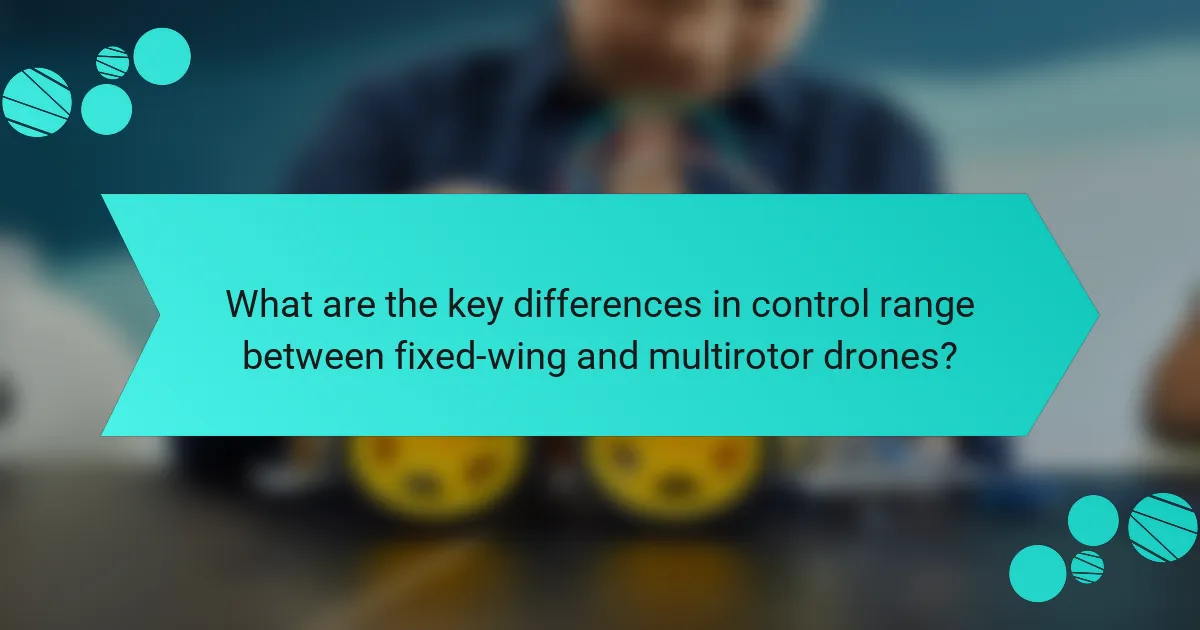
What are the key differences in control range between fixed-wing and multirotor drones?
Fixed-wing drones generally have a longer control range compared to multirotor drones. Fixed-wing designs can achieve ranges of up to 100 kilometers or more due to their aerodynamic efficiency. In contrast, multirotor drones typically have a control range of around 5 to 10 kilometers. This difference is primarily due to the fixed-wing drones’ ability to glide and cover larger distances without expending as much energy. Additionally, fixed-wing drones often utilize advanced communication systems that extend their operational range. Multirotors, while more maneuverable, rely on battery power for vertical lift, limiting their range. The operational environment also affects these ranges, with fixed-wings performing better in open areas, while multirotors excel in urban settings.
What are the typical control ranges for fixed-wing drones?
Typical control ranges for fixed-wing drones vary widely based on design and purpose. Most consumer fixed-wing drones have a control range of about 1 to 10 kilometers. Professional fixed-wing drones can achieve ranges of 10 to 50 kilometers. Some specialized models can extend this range to over 100 kilometers. Factors influencing these ranges include battery capacity, signal strength, and environmental conditions. For example, the DJI Phantom 4 fixed-wing drone has a maximum range of approximately 5 kilometers. In contrast, the senseFly eBee X can reach up to 40 kilometers. These specifications highlight the considerable variability in control ranges among fixed-wing drones.
What are the best practices for maximizing control range in fixed-wing drones?
To maximize control range in fixed-wing drones, pilots should utilize high-gain antennas. High-gain antennas improve signal strength and extend range. Maintaining a clear line of sight between the drone and the transmitter is crucial. Obstacles can disrupt signals and reduce control range. Additionally, optimizing flight altitude can enhance range. Flying at higher altitudes reduces interference from terrain. Using telemetry systems can provide real-time feedback on signal strength. Monitoring this data allows for adjustments during flight. Finally, ensuring firmware is updated can improve communication protocols. Updated firmware often includes enhancements for range and stability.
How do environmental conditions impact control range for fixed-wing drones?
Environmental conditions significantly impact the control range of fixed-wing drones. Factors such as wind speed, temperature, and humidity can alter flight performance. High wind speeds can lead to increased drag, reducing the effective control range. Cold temperatures can affect battery efficiency, limiting operational time and distance. High humidity may influence signal transmission, potentially impacting control reliability. Studies show that adverse environmental conditions can decrease control range by up to 30%. Understanding these variables is crucial for optimizing drone operations in varying environments.
What are the typical control ranges for multirotor drones?
Typical control ranges for multirotor drones vary between 500 meters to 5 kilometers. The range depends on factors such as the drone’s technology, frequency of the controller, and environmental conditions. Consumer-grade multirotor drones often have ranges around 1 kilometer. Professional and racing multirotors can achieve ranges up to 5 kilometers or more. The range is also influenced by the presence of obstacles and interference. In open areas, the maximum range is more easily achieved. Regulations may impose limits on drone operation distances in certain regions.
What are the best practices for maximizing control range in multirotor drones?
To maximize control range in multirotor drones, use high-gain antennas. High-gain antennas improve signal strength and extend range. Ensure the drone’s firmware is updated regularly. Updated firmware can enhance communication protocols. Select optimal frequencies for transmission. Lower frequency bands often provide better range but may have less bandwidth. Maintain a clear line of sight between the drone and the controller. Obstacles can significantly reduce control range. Utilize range extenders or repeaters if necessary. These devices can amplify the signal and increase distance. Monitor battery levels closely. A low battery can reduce transmission power and range.
How do environmental conditions impact control range for multirotor drones?
Environmental conditions significantly impact the control range for multirotor drones. Factors such as wind speed, temperature, and humidity can alter the performance of these drones. High wind speeds can reduce stability and control, causing a decrease in effective range. Temperature affects battery efficiency, with colder conditions leading to reduced flight times. Increased humidity can also impact the electronics and weight of the drone, further limiting range. Studies indicate that optimal conditions yield maximum control range, while adverse weather can reduce it by up to 50%.
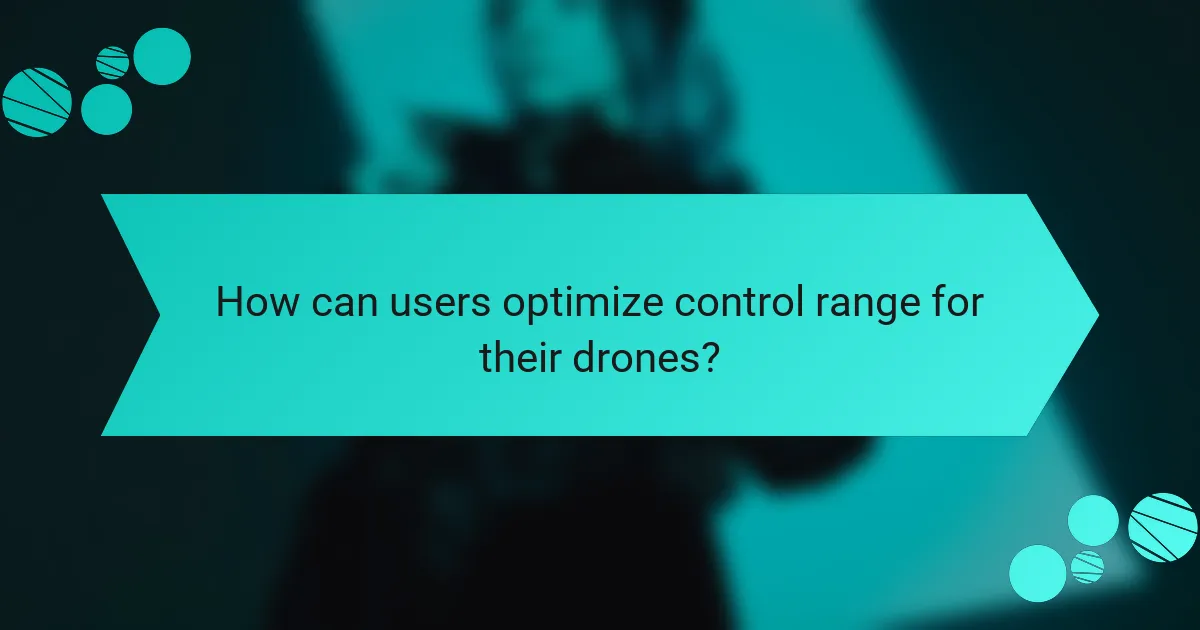
How can users optimize control range for their drones?
Users can optimize control range for their drones by enhancing signal strength and minimizing interference. Upgrading the transmitter and receiver can significantly improve range. Using high-gain antennas increases the effective communication distance. Additionally, flying at higher altitudes reduces obstacles that can block signals. Maintaining a clear line of sight between the drone and controller is crucial. Avoiding urban areas and electromagnetic interference zones also helps extend range. Regularly updating firmware ensures optimal performance and compatibility. These strategies collectively enhance the operational range of both fixed-wing and multirotor drones.
What strategies can be employed to enhance control range in fixed-wing drones?
To enhance control range in fixed-wing drones, several strategies can be employed. Increasing the transmission power of the control signals improves range. Utilizing high-gain antennas can focus the signal, extending the control distance. Implementing advanced communication protocols like frequency hopping can minimize interference, thereby enhancing range. Additionally, optimizing the drone’s flight altitude can reduce obstacles and expand line-of-sight communication. Using relay systems or ground stations can also extend the operational range significantly. Employing GPS-based navigation aids ensures accurate positioning over longer distances. These strategies collectively contribute to improved control range in fixed-wing drones.
How can technology upgrades improve control range for fixed-wing drones?
Technology upgrades can improve control range for fixed-wing drones through enhanced communication systems and advanced navigation technologies. Upgrading to more powerful radio transmitters increases signal strength, allowing for longer distances. Implementing satellite-based navigation systems, like GPS and GNSS, provides precise positioning over vast areas. Additionally, utilizing data link technologies, such as LTE or 5G, allows for real-time data transmission over greater distances.
Research indicates that these upgrades can extend control ranges significantly. For example, a study by the Federal Aviation Administration (FAA) noted that enhanced communication systems could increase operational range by up to 50%. Furthermore, advancements in battery technology can support longer flight times, indirectly improving control range. These improvements collectively enable fixed-wing drones to operate effectively over larger geographic areas.
What are the maintenance tips for ensuring optimal control range in fixed-wing drones?
Regularly check and calibrate the drone’s control systems. This ensures accurate communication between the transmitter and receiver. Inspect antennas for damage or obstructions that could hinder signal strength. Replace worn or damaged components promptly to maintain optimal performance. Keep firmware updated to benefit from improvements in control algorithms. Monitor battery health and charge levels, as low power can affect range. Test the drone in various environments to identify potential interference sources. Conduct pre-flight checks to confirm all systems function correctly before each flight.
What strategies can be employed to enhance control range in multirotor drones?
Increasing control range in multirotor drones can be achieved through several strategies. First, using high-gain antennas can significantly improve signal strength. These antennas enhance the communication link between the drone and the controller. Second, implementing signal repeaters can extend the range by relaying signals. This setup allows for communication over longer distances. Third, optimizing the drone’s firmware can enhance transmission efficiency. Updated firmware often includes improved protocols for data handling. Fourth, utilizing a higher frequency band can reduce interference and boost range. Frequencies like 5.8 GHz are less congested than lower bands. Fifth, increasing the transmission power can directly extend the control range. However, this must comply with local regulations. Lastly, employing telemetry systems can provide real-time data transmission over greater distances. These systems often use dedicated channels to maintain a stable connection. Together, these strategies can effectively enhance the control range of multirotor drones.
How can technology upgrades improve control range for multirotor drones?
Technology upgrades can enhance the control range of multirotor drones through improved communication systems. Advanced radio frequency (RF) technology increases signal strength and reduces interference. This enables longer transmission distances between the drone and the controller. Additionally, the integration of high-gain antennas can significantly extend the operational range. Enhanced GPS technology provides more accurate positioning, which aids in maintaining control over greater distances. Furthermore, software improvements, such as better signal processing algorithms, optimize the drone’s response to commands. These upgrades collectively contribute to a more reliable and extensive control range for multirotor drones.
What are the maintenance tips for ensuring optimal control range in multirotor drones?
Regularly check and calibrate the drone’s transmitter and receiver. This ensures accurate signal transmission. Inspect and maintain the drone’s antennas for damage or obstruction. Properly positioned antennas enhance signal strength. Keep firmware updated to improve performance and control range. Monitor battery health and ensure it is fully charged before flights. A strong battery supports optimal control range. Conduct pre-flight checks to identify any mechanical issues. Regular maintenance helps prevent signal loss during operation.
What are the common challenges faced in achieving optimal control range for both types of drones?
Common challenges in achieving optimal control range for both fixed-wing and multirotor drones include signal interference, battery limitations, and environmental factors. Signal interference can disrupt communication between the drone and the operator, affecting control range. Battery limitations impact the duration and distance a drone can operate effectively. Environmental factors such as wind, obstacles, and terrain can also hinder performance and reduce control range. These challenges necessitate careful planning and technology enhancements to optimize drone operation.
How can users troubleshoot control range issues in fixed-wing drones?
Users can troubleshoot control range issues in fixed-wing drones by checking the transmitter and receiver connection. Ensure the antenna is properly connected and not damaged. Verify that the transmitter batteries are fully charged. Inspect the receiver for any physical obstructions or interference sources. Test the drone in an open area to minimize signal interference. Update the firmware on both the transmitter and receiver to the latest version. Conduct a range test to determine the maximum operational distance. If issues persist, consider upgrading the antenna for improved signal strength.
How can users troubleshoot control range issues in multirotor drones?
Users can troubleshoot control range issues in multirotor drones by checking the transmitter and receiver connections. Ensure that all antennas are properly connected and not damaged. Users should also verify that the battery levels of both the drone and the transmitter are sufficient. Low battery power can lead to reduced control range.
Next, users should inspect the firmware of the drone and transmitter. Outdated firmware can cause connectivity issues. Updating to the latest version can improve performance.
Additionally, users should test for interference from other electronic devices. Wi-Fi networks, cellular signals, and other drones can disrupt communication. Users can change the operating frequency of their transmitter to minimize interference.
Finally, users should perform a range test. This involves flying the drone at a distance while monitoring control response. If issues persist, consulting the manufacturer’s guidelines or customer support may provide further assistance.
Control range comparisons for drones focus on the maximum operational distance between a drone and its controller while maintaining a stable connection. Fixed-wing drones typically achieve longer ranges, often exceeding 100 kilometers, due to their aerodynamic design and efficiency, while multirotor drones generally operate within 1 to 10 kilometers due to battery limitations and rotor configurations. The article explores the factors influencing control ranges for both types of drones, the significance of control range in mission planning, and best practices for maximizing range. It also addresses common challenges and troubleshooting methods for optimizing control range in both fixed-wing and multirotor drones.
